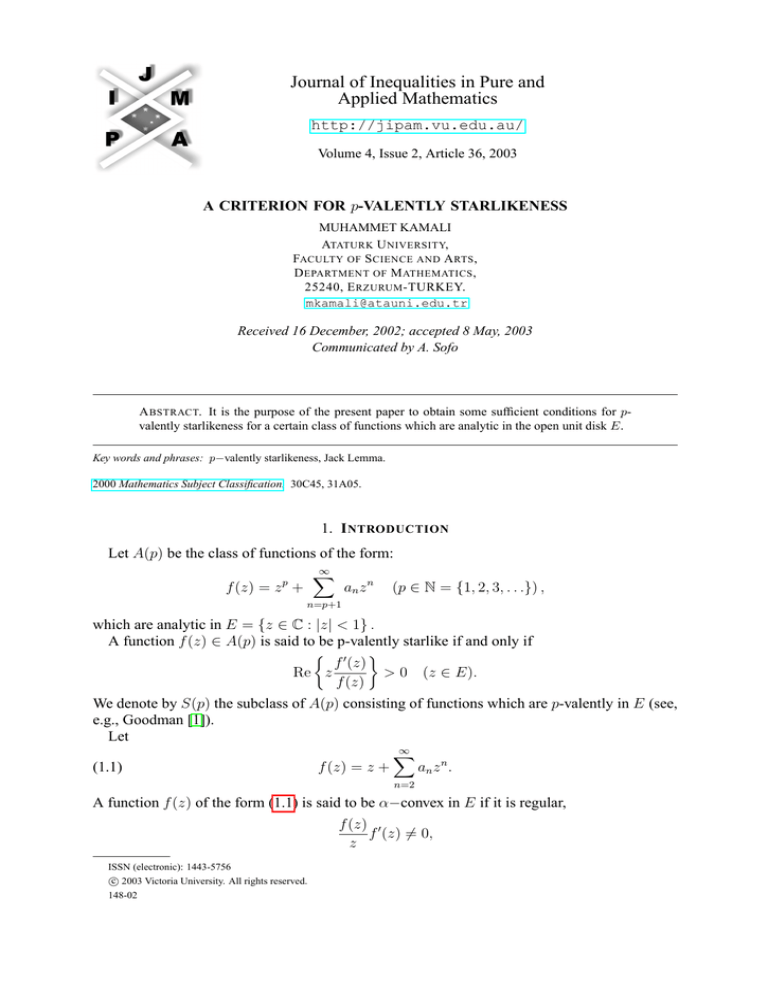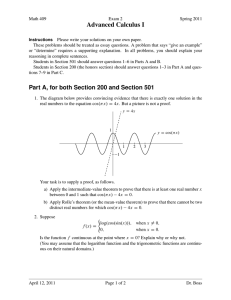
Journal of Inequalities in Pure and
Applied Mathematics
http://jipam.vu.edu.au/
Volume 4, Issue 2, Article 36, 2003
A CRITERION FOR p-VALENTLY STARLIKENESS
MUHAMMET KAMALI
ATATURK U NIVERSITY,
FACULTY OF S CIENCE AND A RTS ,
D EPARTMENT OF M ATHEMATICS ,
25240, E RZURUM -TURKEY.
mkamali@atauni.edu.tr
Received 16 December, 2002; accepted 8 May, 2003
Communicated by A. Sofo
A BSTRACT. It is the purpose of the present paper to obtain some sufficient conditions for pvalently starlikeness for a certain class of functions which are analytic in the open unit disk E.
Key words and phrases: p−valently starlikeness, Jack Lemma.
2000 Mathematics Subject Classification. 30C45, 31A05.
1. I NTRODUCTION
Let A(p) be the class of functions of the form:
∞
X
p
f (z) = z +
an z n (p ∈ N = {1, 2, 3, . . .}) ,
n=p+1
which are analytic in E = {z ∈ C : |z| < 1} .
A function f (z) ∈ A(p) is said to be p-valently starlike if and only if
0 f (z)
Re z
> 0 (z ∈ E).
f (z)
We denote by S(p) the subclass of A(p) consisting of functions which are p-valently in E (see,
e.g., Goodman [1]).
Let
∞
X
(1.1)
f (z) = z +
an z n .
n=2
A function f (z) of the form (1.1) is said to be α−convex in E if it is regular,
f (z) 0
f (z) 6= 0,
z
ISSN (electronic): 1443-5756
c 2003 Victoria University. All rights reserved.
148-02
2
M UHAMMET K AMALI
and
(1.2)
f 00 (z)
f 0 (z)
Re α 1 + z 0
+(1 − α)z
>0
f (z)
f (z)
for all z in E. The set of all such functions is denoted by α − CV , where α is a real number. Of
course, if α = 1, then an α−convex function is convex; and if α = 0, an α−convex function is
starlike. Thus the sets α − CV give a “continuous” passage from convex functions to starlike
functions. Sakaguchi considers functions of the form
p
f (z) = z +
∞
X
an z n ,
n=p+1
where p is a positive integer, and he imposes the condition
zf 00 (z)
f 0 (z)
+ kz
>0
(1.3)
Re 1 + 0
f (z)
f (z)
for z in E. He proved that if k = −1, there is only one function that satisfies (1.3), namely
f (z) ≡ z p . If −1 < k 6 0,then f (z) is p-valent convex; and if 0 < k, then f (z) is p-valent
1
starlike. We can pass from (1.3) back to (1.2) if we divide by 1 + k > 0 and set α = 1+k
[6]. We
denote by S(p, k) the subclass A(p) consisting of functions which satisfy the condition (1.3).
Obradovic and Owa [7] have obtained a sufficient condition for starlikeness of f (z) ∈ A(1)
which satisfies a certain condition for the modulus of
zf 00 (z)
f 0 (z)
0
zf (z)
f (z)
1+
,
we recall their result as:
Theorem 1.1. If f (z) ∈ A(1) satisfies
0 00
zf
(z)
< K zf (z) 1 +
f 0 (z)
f (z) (z ∈ E),
where K = 1.2849..., then f (z) ∈ S(1).
Nunokawa [4] improved Theorem 1.1 by proving
Theorem 1.2. If f (z) ∈ A(p), and if
0 00
1 + zf (z) < zf (z) 1 log(4ep−1 )
f 0 (z) f (z) p
(z ∈ E),
then f (z) ∈ S(p).
2. P RELIMINARIES
In order to obtain our main result, we need the following lemma attributed to Jack [2] (given
also by Miller and Mocanu [3]).
Lemma 2.1. Let w(z) be analytic in E with w(0) = 0. If |w(z)| attains its maximum value in
the circle |z| = r < 1 at a point z0 , then we can write z0 w0 (z0 ) = kw(z0 ), where k is a real
number and k ≥ 1.
Making use of Lemma 2.1,we first prove
J. Inequal. Pure and Appl. Math., 4(2) Art. 36, 2003
http://jipam.vu.edu.au/
A C RITERION FOR p-VALENTLY S TARLIKENESS
3
Lemma 2.2. Let q(z) be analytic in E with q(0) = p and suppose that
0
zq (z)
1
(2.1)
Re
<
(z ∈ E, 0 6 λ 6 1),
2
p(λ + 1)
[q(z)]
then Re{q(z)} > 0 in E.
Proof. Let us put
q(z) = p
1 1
+ λ
2 2
1 + w(z)
+
1 − w(z)
1 1
− λ
2 2
1 − w(z)
1 + w(z)
,
where 0 6 λ 6 1.
Then w(z) is analytic in E with w(0) = 0 and by an easy calculation, we have
1+z
q 0 (z)
2 (λw2 (z) + 2w(z) + λ)zw0 (z)
=
1
+
·
.
p
(w2 (z) + 2λw(z) + 1)2
[q(z)]2
If we suppose that there exists a point z0 ∈ E such that max|z|6|z0 | |w(z)| = |w(z0 )| = 1, then,
from Lemma 2.1, we have z0 w0 (z0 ) = kw(z0 ), (k > 1).
Putting w(z0 ) = eiθ , we find that
z0
q 0 (z0 )
2 λw2 (z0 )w0 (z0 )z0 + 2w(z0 )w0 (z0 )z0 + λw0 (z0 )z0
=
·
p
[w2 (z0 ) + 2λw(z0 ) + 1]2
[q(z0 )]2
2k λe3iθ + 2e2iθ + λeiθ
=
·
p (e2iθ + 2λeiθ + 1)2
2
e−2iθ + 2λe−iθ + 1
2k λe3iθ + 2e2iθ + λeiθ
=
·
·
p
(e2iθ + 2λeiθ + 1)2
(e−2iθ + 2λe−iθ + 1)2
=
k λ cos 3θ + (4λ2 + 2) cos 2θ + (11λ + 4λ3 ) cos θ + (8λ2 + 2)
·
p
4 (λ + cos θ)4
k
=
p
k
=
p
(1 + λ cos θ) (λ + cos θ)2
·
(λ + cos θ)4
1 + λ cos θ
·
,
(λ + cos θ)2
so that
q 0 (z0 )
Re z0
[q(z0 )]2
k 1 + λ cos θ
k λ2 + λ cos θ + 1 − λ2
=
·
·
p (λ + cos θ)2
p
(λ + cos θ)2
k
λ
1 − λ2
=
+
p (λ + cos θ) (λ + cos θ)2
1
1
>
.
p λ+1
=
This contradicts (2.1). Therefore, we have |w(z)| < 1 in E, and it follows that Re {q(z)} > 0
in E. This completes our proof of Lemma 2.2.
If we take λ = 1 in Lemma 2.2, then we have the following Lemma 2.3 by Nunokawa [5].
Lemma 2.3. Let q(z) be analytic in E with q(0) = p and suppose that
0
1
zq (z)
Re
<
(z ∈ E) .
2
2p
[q(z)]
J. Inequal. Pure and Appl. Math., 4(2) Art. 36, 2003
http://jipam.vu.edu.au/
4
M UHAMMET K AMALI
Then Re {q(z)} > 0 in E.
3. A C RITERION FOR p-VALENTLY S TARLIKENESS
Theorem 3.1. Let f (z) ∈ A(p), f (z) 6= 0, in 0 < |z| < 1 and suppose that
h
00
i0
f (z)
f 0 (z)
1 + z f 0 (z) + k f (z)
1
1
(3.1)
Re 1 + z h
(z ∈ E) .
00
i2 < 1 +
0
k + 1 2p
1 + z f 0 (z) + k f (z)
f (z)
f (z)
Then f (z) ∈ S(p, k).
Proof. Let us put
1
q(z) =
k+1
f 00 (z)
f 0 (z)
1+z 0
+ kz
f (z)
f (z)
(k > 0) .
Then, q(z) is analytic in E with q(0) = p, q(z) 6= 0 in E. We have
00 (z)
z ff 0 (z)
0
0 (z)
kz ff (z)
0
+
q 0 (z)
=
00
0 (z)
(z)
q(z)
1 + z ff 0 (z)
+ kz ff (z)
=
f 00 (z)
f 0 (z)
+z
f 00 (z)
f 0 (z)
0
+
0 (z)
k ff (z)
f 00 (z)
+ kz
0
(z)
1 + z f 0 (z) + kz ff (z)
f 0 (z)
f (z)
0
.
Then, we obtain
1
q (z)
=
q(z)
0
z
00 (z)
0 (z)
+ z ff 0 (z)
+ kz ff (z)
−
00
0
(z)
(z)
1 + z ff 0 (z)
+ kz ff (z)
z
2
=1+
f 00 (z)
f 0 (z)
0
00
+k
kz
1
+z
f 0 (z)
f (z)
0
0 (z)
(z)
1 + z ff 0 (z)
+ kz ff (z)
f 0 (z)
f (z)
0
00
+z
f 00 (z)
f 0 (z)
0
0
(z)
(z)
1 + z ff 0 (z)
+ kz ff (z)
−1
,
or
q 0 (z)
(k + 1)q(z) + z
q(z)
0
0 0 (z)
f 00 (z)
2
+ k ff (z)
−1
z
f 0 (z)
+ (k + 1)q(z)
=1+
0 (z)
00 (z)
+ kz ff (z)
1 + z ff 0 (z)
00
00
00
0 (z) 0
0 (z)
0 (z) 2
(z)
(z)
(z)
z 2 ff 0 (z)
+ k ff (z)
+ 2z ff 0 (z)
+ k ff (z)
+ z 2 ff 0 (z)
+ k ff (z)
=1+
00 (z)
0 (z)
1 + z ff 0 (z)
+ kz ff (z)
00
0 00
f (z)
f 0 (z)
f (z)
f 0 (z)
00
z f 0 (z) + k f (z) + f 0 (z) + k f (z)
f (z)
f 0 (z)
=1+z
+
k
+
z
.
f 0 (z)
f 00 (z)
f 0 (z)
f (z)
1+z
+ kz
f 0 (z)
J. Inequal. Pure and Appl. Math., 4(2) Art. 36, 2003
f (z)
http://jipam.vu.edu.au/
A C RITERION FOR p-VALENTLY S TARLIKENESS
5
Thus,
1+
z
q 0 (z)
1
z
=
1
+
z
k + 1 [q(z)]2
f 00 (z)
f 0 (z)
+
0 (z)
k ff (z)
00
0
+
f 00 (z)
f 0 (z)
0
(z)
(z)
1 + z ff 0 (z)
+ kz ff (z)
h
00
i0
0 (z)
(z)
1 + z ff 0 (z)
+ k ff (z)
=1+z 2 .
f 00 (z)
f 0 (z)
1 + z f 0 (z) + kz f (z)
From Lemma 2.3 and (3.1), we thus find that
f 00 (z)
f 0 (z)
Re 1 + z 0
+ kz
>0
f (z)
f (z)
This completes our proof of Theorem 3.1.
If we take α = 0, after writing
follows.
1
k+1
0 (z)
k ff (z)
+
2
(z ∈ E, k > 0) .
= α in (3.1), then we obtain M. Nunokawa’s theorem as
Theorem 3.2. Let f (z) ∈ A(p), f (z) 6= 0, in 0 < |z| < 1 and suppose that
(
00 (z) )
1 + zff 0 (z)
1
Re
< 1 + , z ∈ E.
zf 0 (z)
2p
f (z)
Then f (z) ∈ S(p).
R EFERENCES
[1] A.W. GOODMAN, On the Schwarz-Christoffel transformation and p-valent functions, Trans. Amer.
Math. Soc., 68 (1950), 204–223.
[2] I.S. JACK, Functions starlike and convex of order α, J. London Math. Soc., 2(3) (1971), 469–474.
[3] S.S. MILLER AND P.T. MOCANU, Second order differential inequalities in the complex plane, J.
Math. Anal. Appl., 65 (1978), 289–305.
[4] M. NUNOKAWA, On certain multivalent functions, Math. Japon., 36 (1991), 67–70.
[5] M. NUNOKAWA, A certain class of starlike functions, in Current Topics in Analytic Function Theory, H.M. Srivastava and S. Owa (Eds.), Singapore, New Jersey, London, Hong Kong, 1992, p.
206–211.
[6] A.W. GOODMAN, Univalent Functions, Volume I, Florida, 1983, p.142–143.
[7] M. OBRADOVIC AND S. OWA, A criterion for starlikeness, Math. Nachr., 140 (1989), 97–102.
J. Inequal. Pure and Appl. Math., 4(2) Art. 36, 2003
http://jipam.vu.edu.au/








